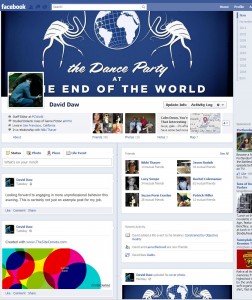Facebook’s timeline layout has greatly influenced how small businesses approach social media. While effective engagement between companies and active users was previously free of charge and dependent upon appealing text, Timeline’s new emphasis on visually prominent and linking posts makes it difficult to connect with users through copy. Furthermore, Timeline’s new layout confuses the dispersion of posts across mobile and web platforms. Facebook circumvents these issues by allowing page managers to pay for promoted posts, advertisements, and sponsored stories directed at a predetermined, targeted demographic of Facebook users. Thus, Facebook is monetizing efficient engagement between businesses and their audience, pushing page managers to trade the opportunity cost of free posts for the actual cost of their new promotions.

The Importance of Images
Since the arrival of Timeline, images and other visual content have played a major role in establishing a brand or individual’s social personality. Profile pictures, which were traditionally a company logo or individual’s headshot, are now accompanied by a large cover photo, which spans the top of the Facebook page. The cover photo’s prominent position ensures that it’s undeniably the first image that any page visitor will see, representing the company’s personality, mission, and current standing.
Cut CopyVisitors are next greeted by the actual Timeline, a linear map of activity that occurs on the page. Before Facebook’s redesign, page managers could write five to six lines of copy in a post before the text was truncated by a “see more” link. The amount of text in a single post is now restricted to two to three lines before the “see more” button appears.
This limiting of text defines two categories of Facebook posts, content-based posts that show engaging material directly to users without requiring additional exertion, like clicking a link, and link-based posts that allow users to view a limited amount of material without additional actions. Timeline has transitioned Facebook posts from content-based to link-based, placing less emphasis on text that can be truncated and more importance on non-truncatable images and links.
Profit Among A Patchwork of Platforms
Facebook’s transition to link based posts has influenced their content far beyond the new emphasis on imagery. Timeline’s layout adjusted to the prominence of visuals, creating what many regard as a rather confusing content graph. The fact that Facebook only transitioned to Timeline on their website, mobile website, and iPad app further confuses the viewing of posts from their native iOS and Android apps, which continues to use Facebook’s original layout of consecutive posts. To counter this difference and possible loss of content, Timeline offers promoted posts, sponsored stories, and Facebook ads as options for page managers to push content and garner “Likes”.
Using a bidding system to establish pricing, promoted posts engage users who are current Fans of a given page by pushing posts to the top of the Fan’s newsfeed, giving them the option of commenting, liking, and/or sharing the post and thus exposing their friends to the company. Sponsored stories are posts created by Facebook (and paid for by the business) that shows friends of the business’ Fans any engagement that the Fan has with the business’s page, allowing outside users to see legitimate interactions between a brand and its active users. The most traditional of Facebook’s new interactions, ads let page managers produce simple advertisements and display them to a highly targeted demographic of Facebook users.

Give and Take
In each of these engagement tactics, pages are trading the physical time and labor that goes into building and engaging Fans with the actual cost of paid promotions. The ability for small businesses to increase the number of “Likes” on their Facebook page without directly paying for their efforts is being replaced by new tactics that require payment to the platform.
While Facebook’s monetization of engagement is a choice opportunity for businesses with social media budgets, the changes make it difficult for small businesses that have less experience with bid-based advertising campaigns and cannot afford promotions that do not show immediate results. While small businesses were previously able to gather Fans for their pages with the only cost being that of opportunity through contests and carefully placed landing pages, they are now forced to break through the newsfeed clatter with paid engagement.
Does this move towards monetization mark the decline of Facebook as a primary marketing tool for small and emerging businesses? Only time will tell if the platform’s new revenue model will sustain itself or if new opportunities will level the playing field for all parties.